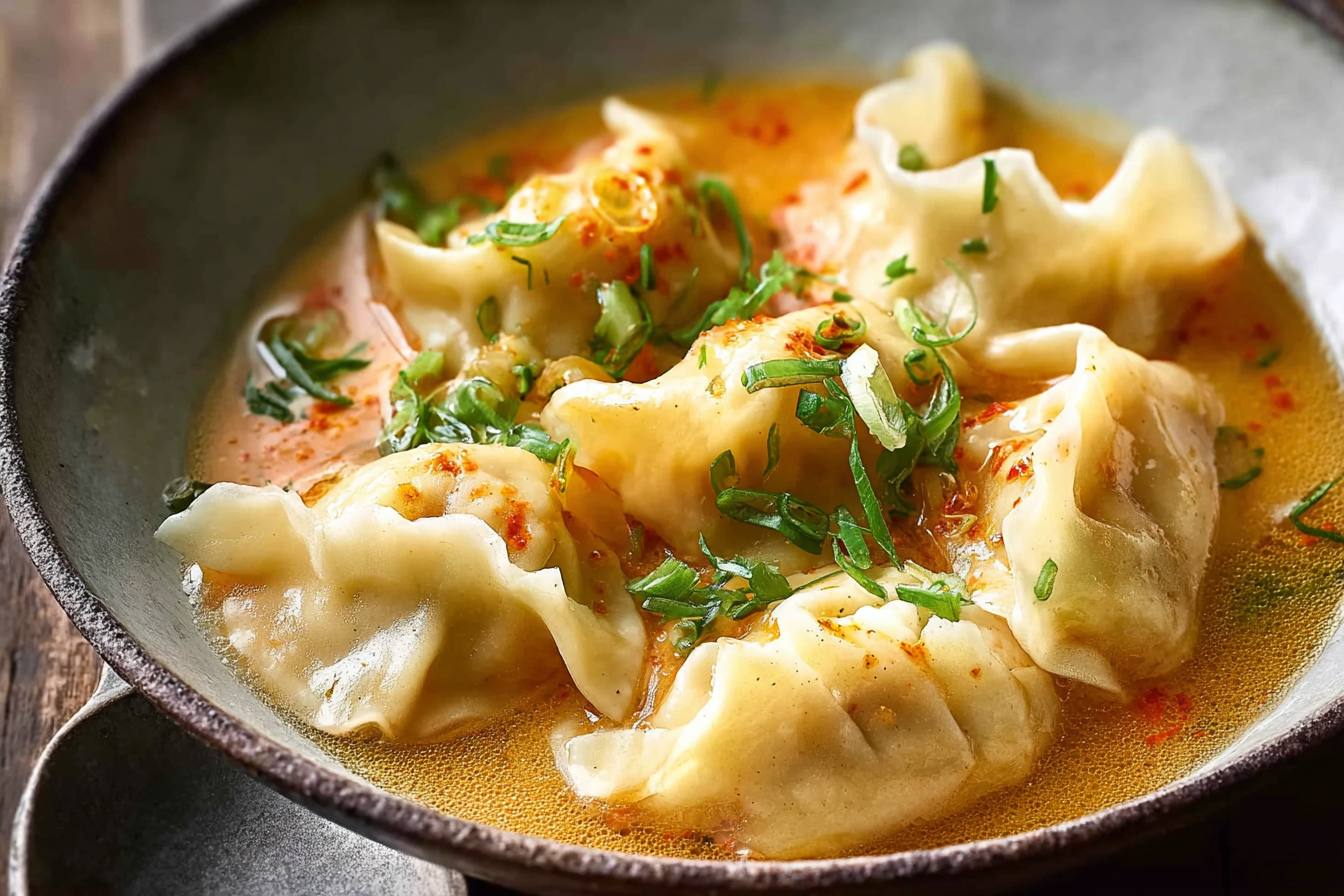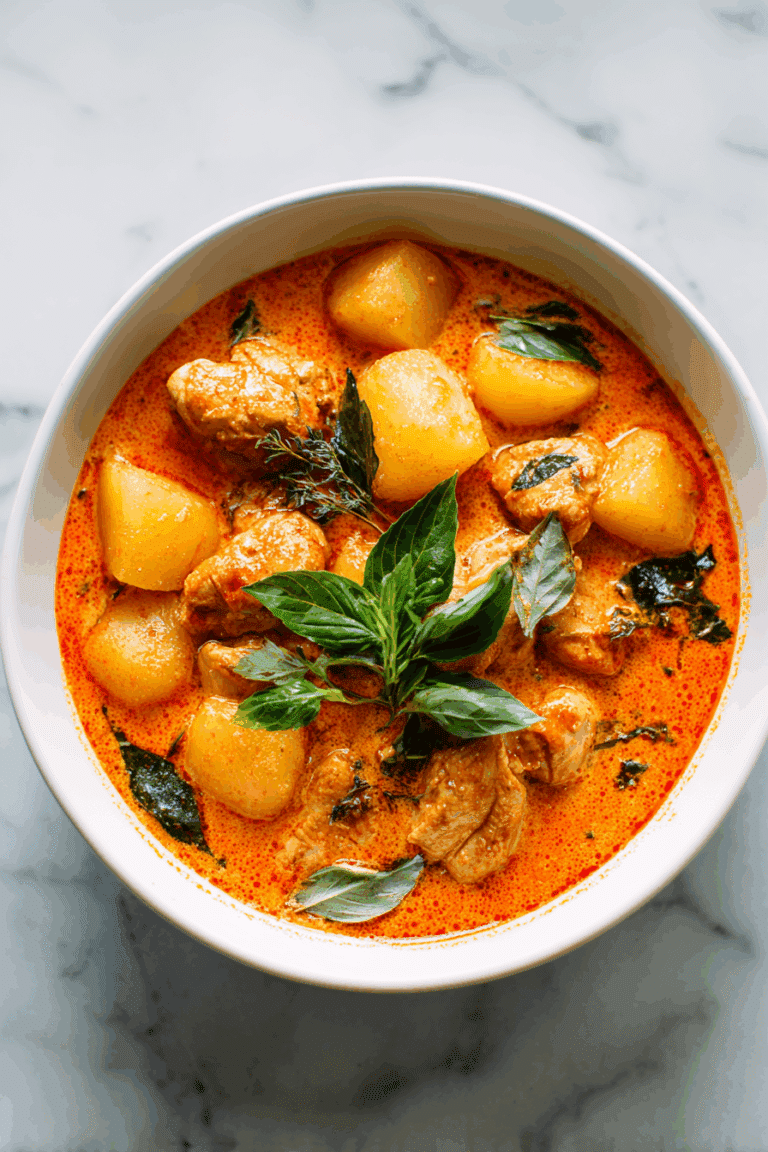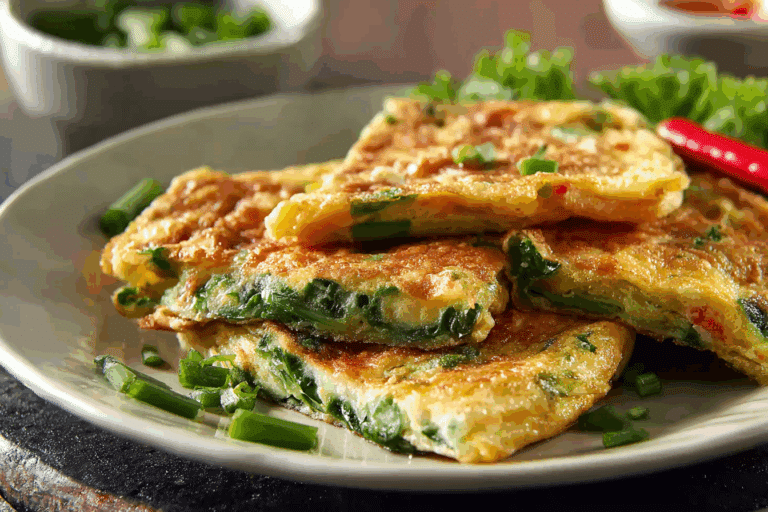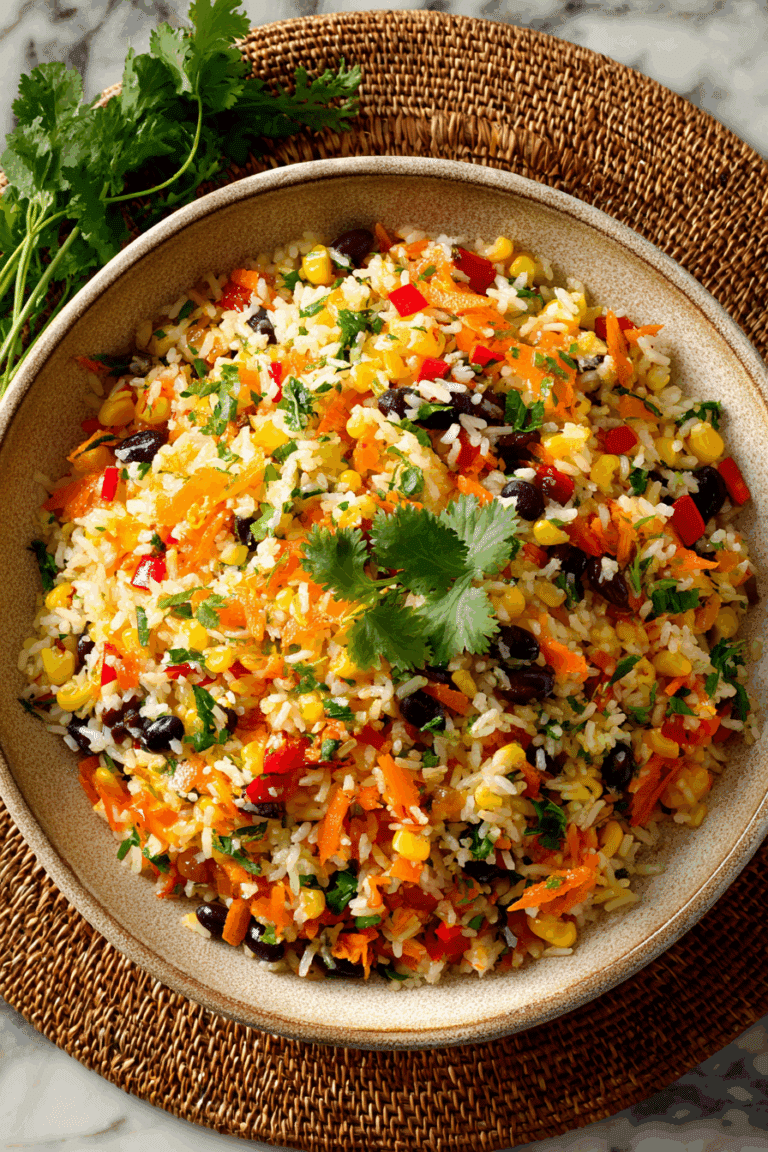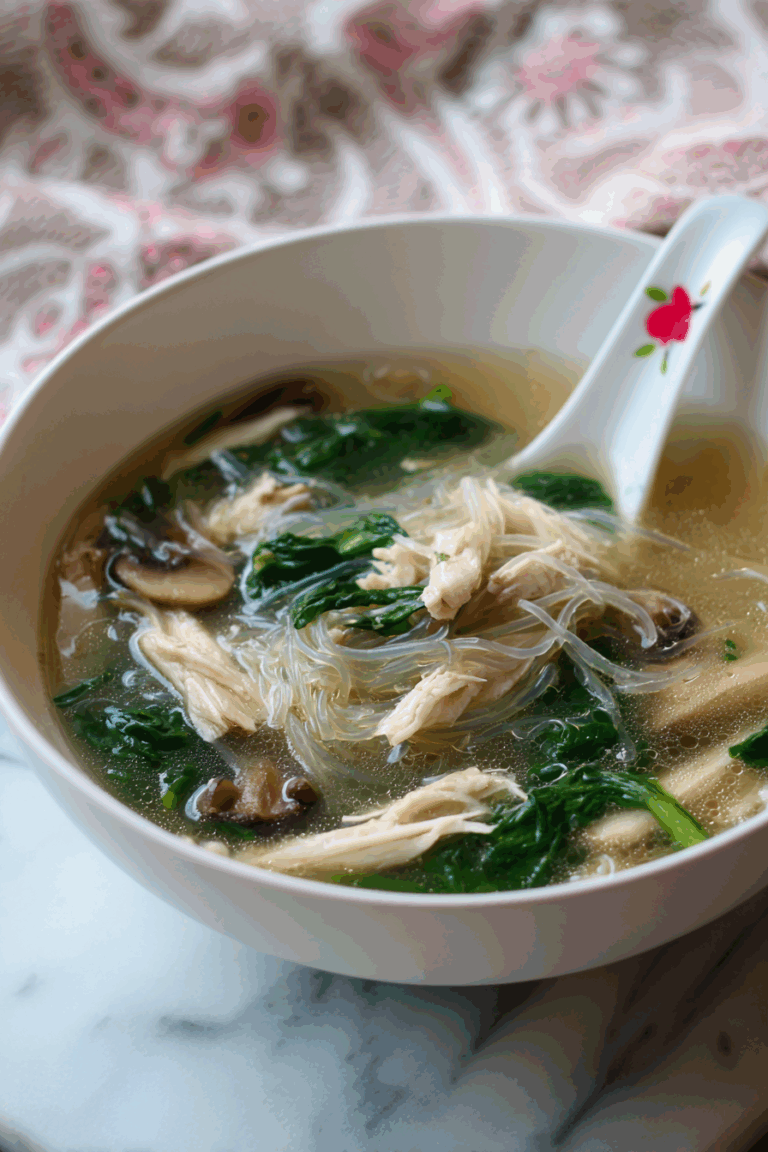Thai Coconut Curry Dumpling Soup Better Than Takeout
Thai Coconut Curry Dumpling Soup is more than just comfort food it’s a cozy Thai hug in a bowl. And here at Just Thai Recipes, it holds a special place in our story. On the About page, Lina, the passionate cook behind the site, shares how this space was born from her deep love for the bold, beautiful flavors of Thai cuisine. With her partner by her side, Lina started Just Thai Recipes to spread the magic of Thai food be it spicy, sweet, or soul-warming like this irresistible dumpling soup.
Crafted with tender gyozas, silky coconut milk, rich Thai red curry, and a hit of fresh lime, this soup is the ultimate one-pot wonder. Whether you’re new to Thai cuisine or a curry lover through and through, this recipe brings together all the elements you crave: savory, creamy, zesty, and utterly satisfying.
In this article, we’ll break down every flavorful detail of Thai Coconut Curry Dumpling Soup, from its authentic ingredients to variations like green or yellow curry versions. We’ll also answer burning FAQs like how to make it healthier or vegan, share serving tips, and even explore its rising fame across Instagram feeds and cozy home kitchens alike.
Don’t miss our beloved Coconut Milk Chicken recipe it’s another crowd-pleaser made with coconut milk!
Table of Contents
Table of Contents
What Is Thai Coconut Curry Dumpling Soup?
Origins and Culinary Roots of Thai Coconut Curry Dumpling Soup
Thai Coconut Curry Dumpling Soup blends the warmth of Thai coconut curry with the comfort of dumplings—a fusion of tradition and innovation. While coconut milk and curry paste have long been Thai culinary staples, the addition of dumplings (or gyozas) offers a modern twist inspired by pan-Asian trends.
The rich base, made from unsweetened full-fat coconut milk, chicken broth, and Thai red curry paste, mirrors the flavors found in classic Thai soups like Tom Kha Gai, but with a chunkier, heartier vibe thanks to the dumplings.
Why It’s Trending: From Instagram to Dinner Tables
Type “red curry dumpling soup Instagram” into search, and you’ll find a sea of vibrant bowls filled with red-tinged broth, gyozas, chives, and colorful veggies. It’s photogenic, yes, but it’s the deep flavor and ease of preparation that’s made it a darling of foodies, bloggers, and home cooks alike.
This soup also aligns perfectly with current food trends:
- One-pot meals
- Global fusion flavors
- Cozy comfort food
- Dairy-free alternatives
It’s no wonder that “authentic Thai coconut curry dumpling soup recipe” is popping up on everyone’s must-cook list.
Ingredients Breakdown for Thai Coconut Curry Dumpling Soup
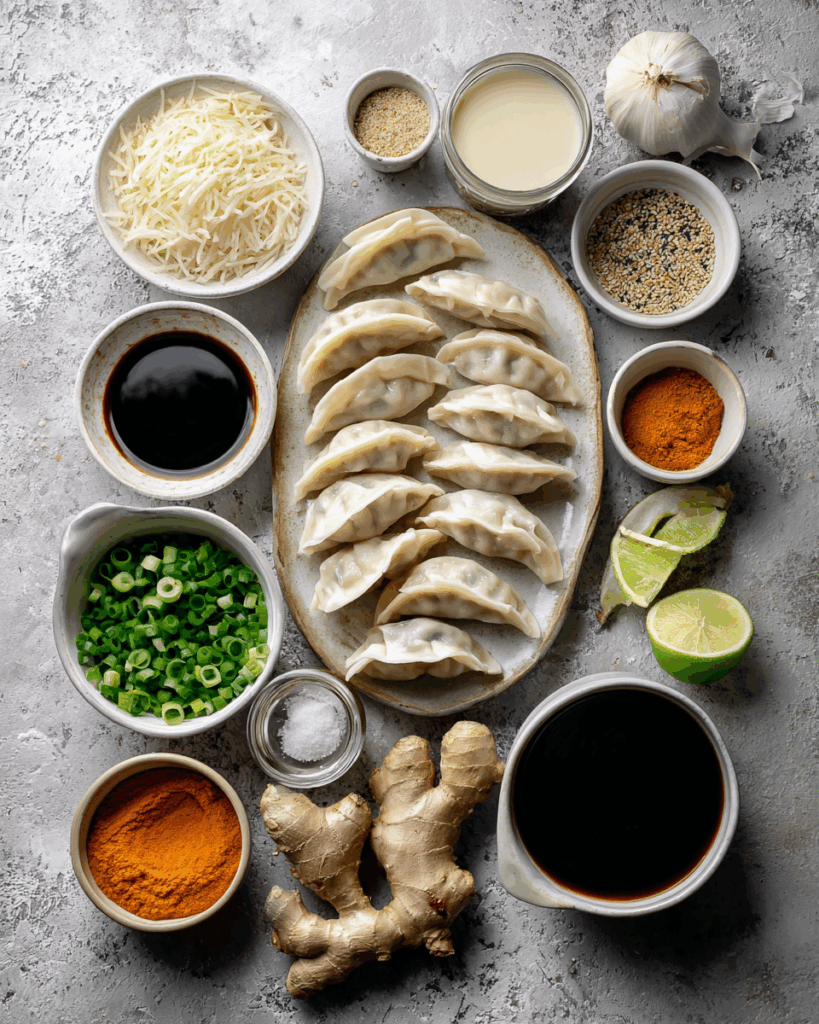
Gyozas or Potstickers: The Soul of the Soup
The heart of this Thai Coconut Curry Dumpling Soup lies in the gyozas. These delicate dumplings are usually filled with pork, chicken, or vegetables and bring a chewy, savory element to the soup. You can use frozen potstickers for convenience or make them from scratch if you want to level up the authenticity. They soak up the coconut curry broth beautifully, creating little flavor bombs in every bite.
Full-Fat Coconut Milk: Creamy Richness in Every Spoon
Using one full can of unsweetened full-fat coconut milk is non-negotiable. It gives the soup its signature creamy consistency and subtle sweetness. Low-fat versions won’t give you the same luxurious mouthfeel. The coconut milk also balances the heat of the curry paste, making the flavor rounded and comforting. If you’re looking for other coconut-rich ideas, discover great ideas like How To Make Thai Crispy Fried Chicken
Thai Red Curry Paste: The Flavor Powerhouse
Thai red curry paste is the driving force behind the soup’s bold, spicy character. It’s made with red chili peppers, lemongrass, galangal, and garlic. When sautéed gently in oil with garlic and ginger, it releases its aromatic compounds, infusing the soup base with that classic Thai flair. You can adjust the quantity to match your heat tolerance, but for full effect, don’t skimp.
Chicken Broth: Depth and Umami
Using 4 cups of chicken broth gives the soup body and depth. It acts as a savory foundation that enhances the richness of the coconut milk. Choose low-sodium broth so you can control the saltiness yourself. For a vegan version, switch to vegetable broth and use mushroom dumplings.
Garlic and Ginger: Fresh, Bold, and Aromatic
Freshly grated garlic and ginger are essential for authenticity. They bring brightness, heat, and a tiny bit of spice that amplifies the curry paste. Sauté them quickly in oil before adding liquids to build flavor from the start.
Soy Sauce, Fish Sauce, and Sesame Oil: Salty, Funky, and Toasted
Each of these sauces adds a unique layer:
- Soy sauce adds salty umami.
- Fish sauce adds a touch of funk and depth.
- Toasted sesame oil introduces a nutty aroma.
Together, they create a complex backdrop that complements the dumplings and curry broth. This combo is what makes it unmistakably Thai in flavor.
Lime Juice and Brown Sugar: The Secret Balancing Act
Just a touch of brown sugar cuts through the spice and salt, while a generous squeeze of lime brightens the entire soup. Thai cuisine is all about balance, and this sweet-acidic finish ensures your soup isn’t just creamy, but dynamic and refreshing.
Chopped Chives and Optional Veggies: The Finishing Touch
Chives add color and a light oniony crunch. For a veggie-packed bowl, toss in bok choy, baby spinach, mushrooms, or shredded carrots just before serving. It’s an easy way to turn this into a more nourishing meal. Looking for inspiration? Try Thai Chicken Bites – The Ultimate Snack You Can’t Stop Eating for other protein-packed Thai dishes.
How to Make Thai Coconut Curry Dumpling Soup Step-by-Step
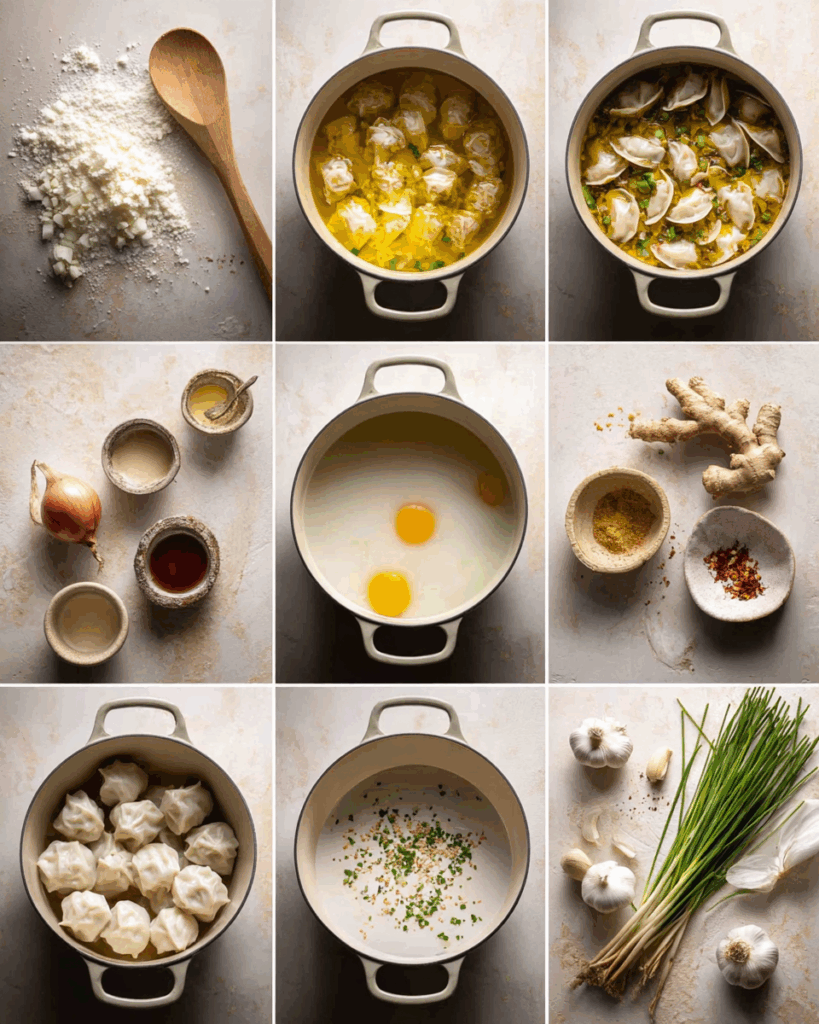
Get Your Prep Done Before Cooking
Start by bringing a large saucepan with salted water to a boil—this will be used to cook the gyozas separately. Meanwhile, grate four garlic cloves and one teaspoon of fresh ginger. Having your aromatics ready ahead of time makes this process quick and smooth. You’ll thank yourself later for this simple prep.
Build the Flavors in Layers
Heat a tablespoon of vegetable oil in a large pot over medium heat. Add the grated garlic and ginger, sautéing them for just 30 seconds until fragrant. This step activates their essential oils and infuses the oil with aromatic depth.
Next, pour in the chicken broth and the coconut milk. Stir gently and let the mixture come together. This is the creamy, comforting base that makes the soup feel indulgent yet fresh.
Season It the Thai Way
Add in the tablespoon of low-sodium soy sauce, one tablespoon of fish sauce, one teaspoon of toasted sesame oil, one teaspoon of brown sugar, three tablespoons of Thai red curry paste, and two tablespoons of fresh lime juice. Stir the soup until the curry paste dissolves completely into the liquid, creating a deep orange broth that smells like your favorite Thai restaurant.
Bring everything to a light boil, then reduce the heat and let it simmer for 5 minutes. This short simmer helps the flavors come together while keeping the brightness of the ingredients intact.
Boil the Gyozas Separately
While the soup is simmering, cook 20 gyozas or potstickers in your prepared pot of boiling water. Follow the directions on your package, which typically suggest 2–3 minutes. Boiling them separately keeps them from soaking up too much liquid too early or breaking apart in the broth.
Once they’re cooked, drain and divide the dumplings into serving bowls.
Finish and Serve with a Touch of Freshness
Ladle the hot coconut curry broth over the dumplings. Garnish each bowl with freshly chopped chives and, optionally, a handful of sautéed or steamed vegetables. A few crunchy toppings like toasted sesame seeds or sliced green onions can add more texture and color.
If you’re still hungry for more variation, discover Thai twists like Whitney Bond’s Thai Coconut Soup with Potstickers, or see how SoupAddict adds her own flavor spin using Thai red curry and dumplings. For a green curry version, try the fresh approach at Marion’s Kitchen. Or if you’re into cozy food blog vibes, check out the nourishing take from Life of Simple Treats.
Tasty Variations of Thai Coconut Curry Dumpling Soup
Thai Coconut Curry Dumpling Soup with Coconut Milk
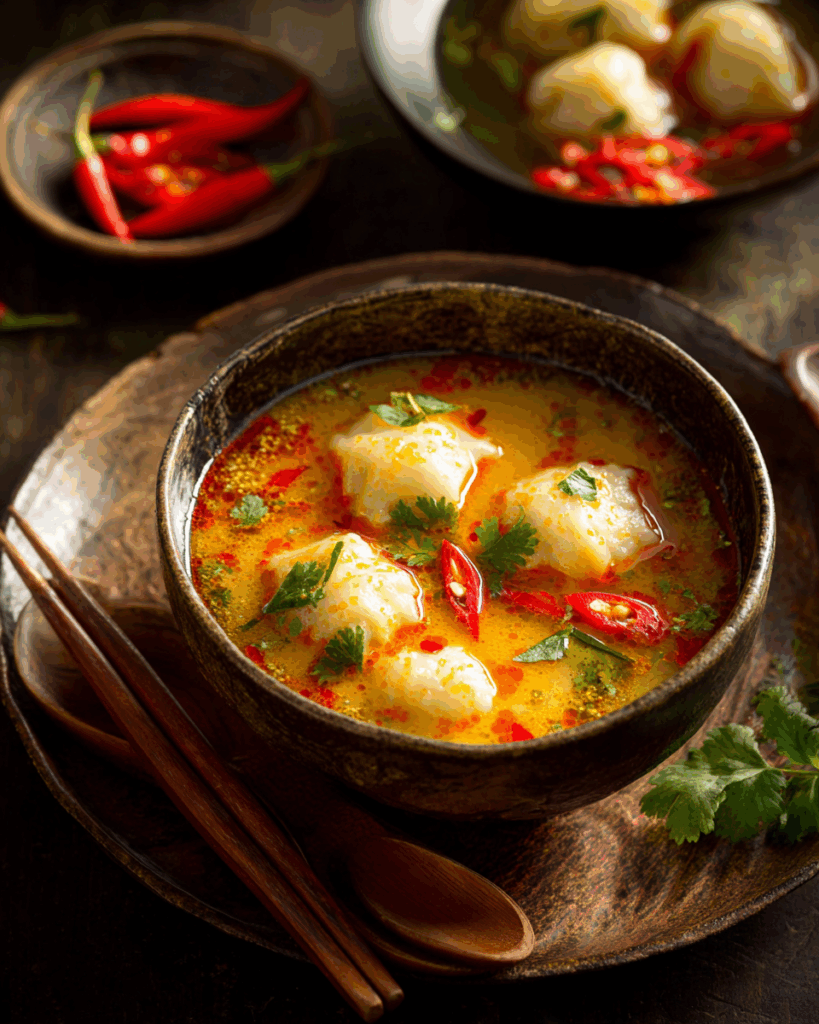
This is the most classic and beloved version. Made with full-fat unsweetened coconut milk, it creates a creamy, velvety broth that hugs every dumpling. This version emphasizes smooth richness and balances the bold heat from the Thai red curry paste. The natural sweetness of coconut milk also mellows out the fish sauce and lime juice, making each bite well-rounded and comforting. For anyone trying the dish for the first time, this is the must-try version that defines what Thai Coconut Curry Dumpling Soup should taste like.
Easy Thai Red Curry Dumpling Soup Recipe
Want a faster version that doesn’t skip on flavor? This variation is ideal. You can use pre-cut vegetables, frozen dumplings, and store-bought curry paste for a meal that’s ready in under 30 minutes. The steps remain the same, but with fewer ingredients and lighter preparation, making it great for busy weeknights. Just be sure to keep the essentials—coconut milk, red curry paste, and lime juice—to preserve the dish’s authentic Thai identity.
Authentic Thai Coconut Curry Dumpling Soup
When aiming for the most authentic flavor, it’s all about using traditional Thai pantry ingredients. Instead of using vegetable broth, go for a homemade chicken stock simmered with lemongrass, galangal, and kaffir lime leaves. Choose dumplings filled with Thai-seasoned ground chicken or shrimp, and don’t hold back on garnishing with Thai basil and fresh cilantro. Authentic Thai coconut curry dumpling soup doesn’t rely on shortcuts—it’s a slow, mindful build of layers that ends in a bowl exploding with complex, traditional Thai flavors.
Authentic Thai Coconut Curry Dumpling Soup Recipe
For those craving a full step-by-step breakdown of the most traditional way to make it, you can follow a more detailed recipe route. This version will often include homemade red curry paste using mortar and pestle, hand-folded dumplings filled with seasoned pork, and fresh produce like Thai eggplant, mushrooms, and even bamboo shoots. The final touch may even involve a dash of chili oil or fried garlic for extra fragrance and bite.
Green Curry Dumpling Soup
Green curry fans, this variation is made for you. Swap red curry paste with green curry paste for a slightly sweeter and herbier flavor profile. Green curry brings more lemongrass, Thai basil, and fresh green chili notes. It pairs especially well with chicken or vegetable dumplings and crisp vegetables like snap peas and green beans. The coconut milk still provides creaminess, but the overall feel is brighter, fresher, and lighter in spice.
Yellow Curry Dumpling Soup
Milder and earthier, yellow curry paste delivers a warm turmeric-based broth. This version is perfect for those who prefer mellow heat. The sweetness of coconut milk blends beautifully with the aromatic blend of cumin, coriander, cinnamon, and turmeric found in yellow curry paste. Chicken or vegetable dumplings fit right in, and garnishes like crispy shallots or roasted peanuts can add texture and richness to this comforting variation.
Thai Coconut Curry Dumpling Soup Ingredients: Customization Ideas
Beyond curry paste swaps, there are countless ways to tailor the soup to your preference:
- Use vegetable dumplings for a meatless version
- Replace chicken broth with mushroom or veggie broth for vegans
- Add sliced mushrooms, baby corn, or bok choy for color and nutrition
- Spice things up with crushed chili flakes or a drizzle of sriracha
- Finish with fresh Thai herbs for added aroma and authenticity
These variations don’t just add flexibility to the dish—they help make Thai Coconut Curry Dumpling Soup a regular in your kitchen rotation, no matter the mood or dietary need.
Health Benefits and Dietary Adaptations of Thai Coconut Curry Dumpling Soup
A Nutritious One-Bowl Meal
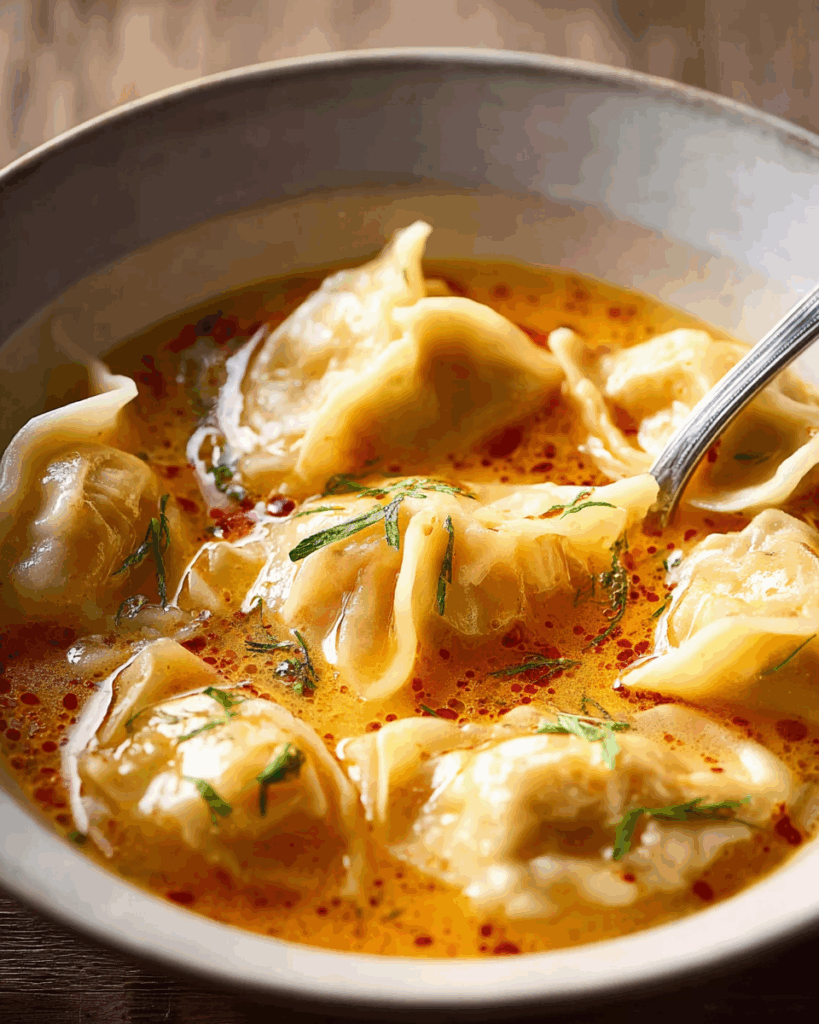
Thai Coconut Curry Dumpling Soup isn’t just flavorful—it’s surprisingly balanced and nourishing. The combination of protein-rich dumplings, immune-boosting garlic and ginger, and creamy coconut milk makes for a well-rounded dish. Coconut milk contains medium-chain triglycerides (MCTs), which may support metabolism and provide a quick source of energy. Meanwhile, ginger and garlic have anti-inflammatory properties and are known to aid digestion.
If you include vegetables like spinach, mushrooms, carrots, or bok choy, you’re adding fiber, antioxidants, and essential vitamins into the mix. This makes the soup not only tasty but deeply satisfying on a nutritional level.
Vegan and Vegetarian-Friendly Options
Making this soup vegan is easy. Swap out the chicken broth for vegetable broth, and choose vegetable dumplings instead of meat-filled ones. For umami, replace the fish sauce with soy sauce or tamari. You can also add miso paste or a splash of rice vinegar to mimic the savory depth fish sauce usually provides.
If you’re strictly vegetarian but not vegan, feel free to include egg-based dumplings. The key is to maintain the balance between creamy, spicy, salty, and sour, which defines Thai cuisine.
Gluten-Free Substitutions
For those avoiding gluten, look for gluten-free dumplings at your local store or make your own using rice flour wrappers. Also, make sure the soy sauce you use is gluten-free—tamari is often a safe bet. Coconut milk, fresh vegetables, and spices are naturally gluten-free, so with a few smart swaps, this soup becomes safe for anyone with gluten sensitivity.
Keto and Low-Carb Versions
While traditional dumplings may be too high in carbs for strict keto followers, you can still enjoy a low-carb take on this dish. Replace dumplings with meatballs made of ground chicken, pork, or tofu. They absorb the curry broth beautifully while staying keto-friendly. Another option is using shirataki or zucchini noodles as a filler to mimic the dumpling experience.
Also, keep the sugar low by skipping the brown sugar or replacing it with a keto-approved sweetener like monk fruit or erythritol. Stick to low-carb vegetables like mushrooms, spinach, and zucchini to keep it fully aligned with low-carb eating plans.
Low-Sodium and Heart-Friendly Version
For those watching sodium, it’s easy to cut back without losing flavor. Use low-sodium broth and go light on the soy and fish sauces. Instead, let the natural herbs and spices shine—garlic, ginger, lime juice, and curry paste already bring powerful taste to the table. You can also increase fresh veggies for volume and use tofu dumplings as a lighter alternative.
No matter your dietary style, Thai Coconut Curry Dumpling Soup is adaptable. It proves that healthy and delicious don’t have to be separate ideas.
Serving Tips, Storage, and Reheating Like a Pro
Best Ways to Serve Thai Coconut Curry Dumpling Soup
The presentation of this soup can elevate the dining experience from cozy to spectacular. Serve it hot in wide, deep bowls to showcase the rich, colorful broth and perfectly placed dumplings. Garnish with a sprinkle of chopped chives, a wedge of lime on the side, and if you’re feeling fancy, a swirl of chili oil or toasted sesame seeds. For extra texture, top with crispy shallots or crushed peanuts.
Add sautéed greens or steamed veggies like bok choy, mushrooms, or shredded carrots just before serving to boost both nutrition and visual appeal. You can even set up a mini garnish bar so everyone can customize their bowl. A handful of fresh herbs—cilantro, Thai basil, or mint—can add brightness and aroma, especially for more authentic or elevated versions.
Thai Coconut Curry Dumpling Soup pairs well with jasmine rice or sticky rice if you want to turn it into a full meal. A light Thai salad on the side brings freshness to balance the creamy base.
Make-Ahead Tips for Busy Schedules
If you plan to make this ahead of time, keep a few things in mind. Cook the broth and dumplings separately and store them apart until you’re ready to serve. This prevents the dumplings from turning soggy or falling apart. When ready to eat, simply heat the broth, warm the dumplings in hot water or microwave for a few seconds, then combine just before serving.
You can prepare the soup base up to three days in advance. It often tastes better the next day as the flavors deepen overnight in the fridge.
How to Store Leftovers
Leftovers should be cooled to room temperature before being stored. Store the broth and dumplings separately in airtight containers in the refrigerator. The soup base will stay fresh for up to 4 days, while dumplings are best consumed within 2 to 3 days.
For freezing, freeze only the soup base. Coconut milk can sometimes separate when frozen, but a gentle stir while reheating can restore its creamy texture. Dumplings generally don’t freeze well once cooked, so if you plan on freezing, store uncooked dumplings separately in a freezer bag.
Reheating Without Losing Flavor or Texture
To reheat the soup base, pour it into a saucepan and warm it over medium heat, stirring occasionally. Avoid boiling the soup to preserve the integrity of the coconut milk and maintain its smoothness.
Dumplings can be reheated in a steamer basket, microwave, or by briefly boiling in water. Once both parts are hot, combine them in a bowl for a ready-to-enjoy meal that tastes just as good as when it was first made.
Whether you’re meal-prepping, enjoying leftovers, or whipping up a quick weekday dinner, these serving and storage tips ensure your Thai Coconut Curry Dumpling Soup remains just as delicious and comforting every time.
Expert Tips and Common Mistakes When Making Thai Coconut Curry Dumpling Soup
Pro Tips for Nailing Thai Coconut Curry Dumpling Soup Every Time
Thai Coconut Curry Dumpling Soup is incredibly forgiving, but a few expert moves can take it from great to unforgettable. First, always sauté your garlic and ginger before adding liquids. This small step unlocks essential flavor oils that form the backbone of the soup’s taste.
Next, dissolve the Thai red curry paste fully before simmering. Stir it well in the oil or hot broth to prevent clumping and uneven flavor. To intensify the curry notes, allow the paste to toast lightly for 30 seconds in the oil before adding broth and coconut milk.
When cooking the dumplings, do it in a separate pot of boiling water, not directly in the soup. This avoids starchy residue and prevents them from falling apart. Drain them well before transferring to bowls.
Use full-fat coconut milk only. Light versions don’t deliver the rich texture that makes Thai Coconut Curry Dumpling Soup so indulgent. Shake the can before opening to mix the cream and liquid naturally separated inside.
Lastly, finish with lime juice and fresh chives just before serving. These final touches brighten the dish and cut through the creamy curry broth for a more layered flavor experience.
Common Mistakes to Avoid When Making Thai Coconut Curry Dumpling Soup
Using too much curry paste without balancing it with coconut milk can make the soup overwhelmingly spicy. For beginners, start with one tablespoon of paste, then adjust after tasting.
Don’t skip the lime juice or sugar. Many first-time cooks leave them out, but Thai cuisine is built on balance—salty, sweet, sour, and spicy. Brown sugar and lime juice aren’t optional; they’re critical to making Thai Coconut Curry Dumpling Soup taste authentic and full-bodied.
Overcooking the dumplings is another frequent mistake. Boil them just until they float and appear plump. If they’re left too long in the soup, they can become soggy or burst open, releasing filling into the broth.
Using low-quality curry paste can lead to a flat, lifeless soup. Opt for reputable Thai brands or make your own paste using fresh ingredients like chilies, lemongrass, and shallots. Good paste equals bold, aromatic soup.
Avoid overcrowding the pot. Give your dumplings space and add veggies at the right time—after the soup simmers—so they stay vibrant and don’t turn mushy.
Always taste before serving. Adjust lime, sugar, or salt at the end, not during simmering. Thai Coconut Curry Dumpling Soup evolves as it cooks, and those final tweaks bring it all together.
Final Thoughts on Thai Coconut Curry Dumpling Soup
Thai Coconut Curry Dumpling Soup is more than just a meal—it’s an experience. From the first sizzle of garlic and ginger in hot oil to the final swirl of creamy red curry broth poured over tender dumplings, this dish delivers comfort, bold flavor, and Thai soul in every spoonful. Whether you’re craving a rich and spicy version made with red curry paste or a milder twist using yellow curry, there’s room to experiment and personalize the soup to your mood and dietary preferences.
Its rising popularity isn’t surprising. It fits perfectly into the modern love for one-bowl meals that are as Instagram-worthy as they are heartwarming. And it’s flexible—ideal for weeknight dinners, dinner parties, or prepping ahead for cozy lunches. It’s naturally dairy-free, easily made vegan or gluten-free, and adaptable for low-carb or high-protein diets.
Remember to focus on quality ingredients. Use full-fat coconut milk, fresh aromatics, and the best curry paste you can find. Don’t forget the finishing touches: a squeeze of lime juice, a pinch of chives, and your favorite vegetables bring brightness and balance to the deep curry flavors.
So the next time you want a warm, exciting, and satisfying meal that feels like a trip to Thailand in a bowl, make Thai Coconut Curry Dumpling Soup. Your taste buds will thank you.
Looking for inspiration? Try our Thai Coconut Curry Meatballs recipe—it’s packed with the same bold, creamy flavors in a whole new format you’ll love.
FAQs About Thai Coconut Curry Dumpling Soup
Can I make a vegan or dairy-free version of Thai Coconut Curry Dumpling Soup?
Absolutely. This soup is naturally dairy-free thanks to coconut milk. To make it fully vegan, swap the chicken broth for vegetable broth, use vegan dumplings, and replace fish sauce with soy sauce or a splash of tamari with a dash of rice vinegar for tang. The soup remains rich, flavorful, and comforting, even without animal products. Plus, it’s a great way to introduce plant-based meals that still deliver bold Thai flavor.
How spicy is Thai Coconut Curry Dumpling Soup?
The spice level depends on the red curry paste you use and how much you add. Thai red curry paste has a moderate heat level with chili, garlic, and lemongrass. To make it milder, use just one tablespoon and increase coconut milk slightly. Want more heat? Add extra curry paste, sliced Thai chilies, or a spoonful of chili oil. You can fully control the spice level, making it kid-friendly or fiery hot depending on your taste.
Can I make Thai Coconut Curry Dumpling Soup ahead of time?
Yes, but there’s a trick to it. Make the soup base ahead—up to three days in advance—and store it separately from the dumplings. This prevents the dumplings from becoming mushy. When ready to serve, reheat the broth and cook or reheat the dumplings separately, then combine them in a bowl. For even more depth of flavor, the broth actually improves after sitting for a day as the ingredients mingle and intensify.
What is the best type of dumpling to use in Thai Coconut Curry Dumpling Soup?
You can use either store-bought frozen gyozas or fresh handmade dumplings—both work beautifully. Pork, chicken, shrimp, and veggie-filled dumplings are all great choices. For traditional flavor, pork or chicken dumplings seasoned with garlic, ginger, and scallions pair perfectly with the curry broth. If you prefer plant-based options, opt for tofu and vegetable dumplings, or mushroom-filled versions. Dumplings that hold their shape during boiling and don’t fall apart are ideal.
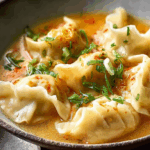
Thai Coconut Curry Dumpling Soup
- Prep Time: 10 minutes
- Cook Time: 15 minutes
- Total Time: 25 minutes
- Yield: 4 servings 1x
- Category: Soup
- Method: Stovetop
- Cuisine: Thai
- Diet: Halal
Description
A comforting Thai Coconut Curry Dumpling Soup featuring gyozas in a rich, creamy, and aromatic coconut curry broth. Perfect for cozy nights with optional veggies for a nutritious twist.
Ingredients
- 20 gyozas or potstickers
- 1 tbsp vegetable oil
- 4 garlic cloves, grated
- 1 tsp grated ginger
- 4 cups chicken broth
- 1 can (14 oz/400 ml) unsweetened coconut milk, full fat
- 1 tbsp low sodium soy sauce
- 1 tbsp fish sauce
- 1 tsp toasted sesame oil
- 3 tbsp Thai red curry paste
- 1 tsp brown sugar
- 2 tbsp lime juice
- Chopped chives, for serving
- Your favorite vegetables, optional for serving
Instructions
- Bring a large saucepan with salted water to a boil. Grate the garlic and ginger.
- Heat vegetable oil over medium heat in a large pot. Add garlic and ginger; sauté for 30 seconds.
- Pour in chicken broth and coconut milk. Add soy sauce, fish sauce, sesame oil, Thai red curry paste, brown sugar, and lime juice. Stir until curry paste dissolves.
- Bring the soup to a boil, then reduce to a simmer for 5 minutes.
- Meanwhile, cook gyozas in the boiling water according to package directions (about 2–3 minutes), then drain.
- Divide gyozas between serving bowls. Pour hot coconut curry soup over them.
- Top with chopped chives and your favorite vegetables if desired. Serve hot and enjoy!
Notes
- Use frozen or fresh gyozas – either work well.
- Customize with veggies like spinach, bok choy, or mushrooms for added nutrition.
- Adjust curry paste to taste for spice level.
- Make it vegetarian by using veggie broth and skipping fish sauce.
Nutrition
- Serving Size: 1 bowl (about 2 cups)
- Calories: 340
- Sugar: 4g
- Sodium: 980mg
- Fat: 21g
- Saturated Fat: 12g
- Unsaturated Fat: 8g
- Trans Fat: 0g
- Carbohydrates: 26g
- Fiber: 2g
- Protein: 9g
- Cholesterol: 10mg
Keywords: Thai coconut curry soup, dumpling soup, gyoza curry soup, Thai red curry, coconut milk soup

